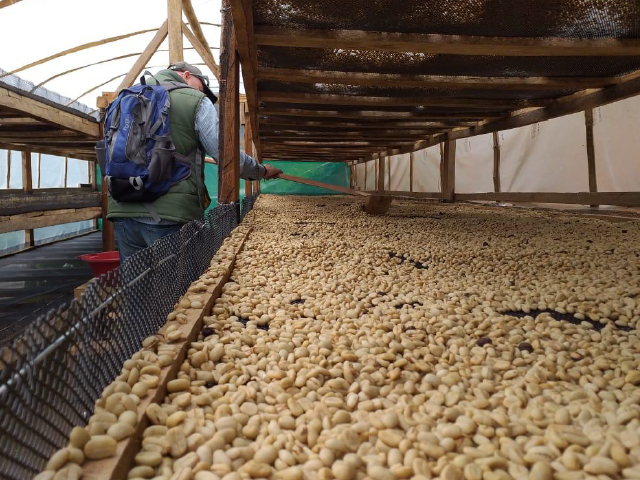Champion recommended Peruvian coffee bean flavor and taste characteristics Peruvian coffee bean output and historical development story
What's so special about the coffee beans that the champions have agreed on? On April 1st, three-time Australian barista champion Hugh Kelly released an ins, praising a coffee bean from Peru. What is so special about coffee in this country? Today, let Qianjie lead us to get to know Peruvian coffee again.
The Peruvian Andes are an excellent environment for growing high-altitude coffee: Peruvian coffee grows between 1970 and 5905 feet above sea level, although 75 per cent of coffee plantations are located above 3280 feet. As for boutique coffee, they usually grow at an altitude of more than 4265 feet. In addition, Peru's many microclimates make it one of the most biologically diverse countries in the world.

Coffee flavor characteristics: crisp acidity, medium-bodied wine, vibrant floral aroma, rich sweetness.
Processing method: wet method, water washing
Main producing areas: Amazon, Ayakucho, Cusco, Vanako
Harvest time: June to September
In addition to Brazil, there is another major coffee producer, although it does not appear in the top five producers, but it has made a significant contribution to the global production of coffee beans. The producer is Peru.

About the mid-1700s. Since then, Peruvian coffee has grown steadily and become one of the favorite coffees of many people around the world. In 2017, Peru ranked 10th on the list of the world's largest coffee producers. This is a good reason to show you that Peruvian coffee is not weak. Growing more than 3.2 billion bags of 60 kilograms of delicious coffee a year, Mexico is the second largest exporter of Fairtrade coffee and deserves to know more about Peruvian coffee. Let's start with its history. The late 1800s were not the best years for countries such as Indonesia and its neighbors. A terrible disease has greatly affected the growth of coffee in these countries, prompting European buyers to look for alternative producers around the world to meet Europe's insatiable demand for coffee. It was during that period that Peruvian coffee was discovered. This discovery has made a significant contribution to healthy Peruvian coffee and its economic growth.
Like most of the top coffee producers who have been improving in coffee production for years, Peruvian coffee has a bright future. It has made positive progress in healthy production and high quality beans. This development has enabled Peru to compete with top coffee producers such as Brazil and Colombia. Today, Peru has more than 100000 farmers, a large proportion of whom grow traditional, shaded Arabica coffee beans, which are quickly respected on the international market.
It is one of the largest producers of organic, rainforest alliance and UTZ certified coffee in the world. Visit the International Federation of Organic Agriculture movements (IFOAM) to learn more about other certified organic coffee producers.
Farmers belong to local cooperatives, which helps their beans reach a wider audience and get a fairer price for their beans. It is through these cooperatives that local farmers can demand decent living and fair wages for their hard work.
Peruvian coffee is a pure Arabica coffee type. 70% of them are Typica,20% and 10% are Carurra, and the other 10% are distributed in other varieties.
Coffee is hand-selected, and the higher the altitude, the greater the risk. To extract the pulp from the beans, wash the cherries and dry them in the sun. Peruvian coffee is usually processed dry, but wet processing also has a small market.
The International Coffee Organization (ICO) has positioned Peru as the ninth largest coffee producer in the world, with 223902 households dedicated to the industry.
Peruvian coffee tends to be medium. They are also mellow and pleasant with moderate acidity. You can't resist the rich sweetness of this coffee.
Peruvian coffee producing areas include Amazon, Ayakucho, Cajamaka, Cusco, Vanuco, Hunin, Pascoe, Piura, Puno and San Martin.
Important Notice :
前街咖啡 FrontStreet Coffee has moved to new addredd:
FrontStreet Coffee Address: 315,Donghua East Road,GuangZhou
Tel:020 38364473
- Prev

The source of coffee sweetness the effect of coffee roasting on the flavor of coffee beans how to extract coffee correctly
Coffee extraction is just the process of dissolving coffee powder in hot water, right? Well, yes. But in order to get the perfect cup of coffee, there is some science that can solve this problem. The ratio of water to coffee, the precision of grinding, the roasting degree of coffee, the temperature of water and the contact time between water and coffee are only a small part of the extraction of coffee.
- Next

How to get sweetness in coffee Maillard reaction of roasted coffee beans strawberry sweet flavor coffee
That's part of the reason why it's so important that pickers are well trained and paid. Only ripe cherries.
Related
- Detailed explanation of Jadeite planting Land in Panamanian Jadeite Manor introduction to the grading system of Jadeite competitive bidding, Red bid, Green bid and Rose Summer
- Story of Coffee planting in Brenka region of Costa Rica Stonehenge Manor anaerobic heavy honey treatment of flavor mouth
- What's on the barrel of Blue Mountain Coffee beans?
- Can American coffee also pull flowers? How to use hot American style to pull out a good-looking pattern?
- Can you make a cold extract with coffee beans? What is the right proportion for cold-extracted coffee formula?
- Indonesian PWN Gold Mandrine Coffee Origin Features Flavor How to Chong? Mandolin coffee is American.
- A brief introduction to the flavor characteristics of Brazilian yellow bourbon coffee beans
- What is the effect of different water quality on the flavor of cold-extracted coffee? What kind of water is best for brewing coffee?
- Why do you think of Rose Summer whenever you mention Panamanian coffee?
- Introduction to the characteristics of authentic blue mountain coffee bean producing areas? What is the CIB Coffee Authority in Jamaica?

